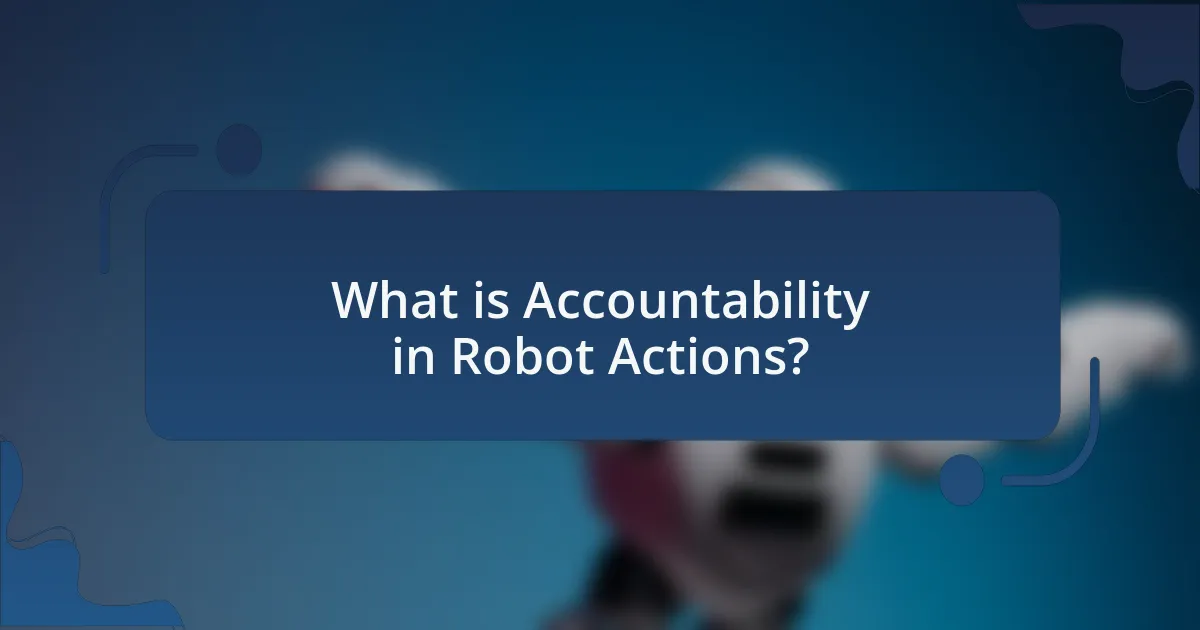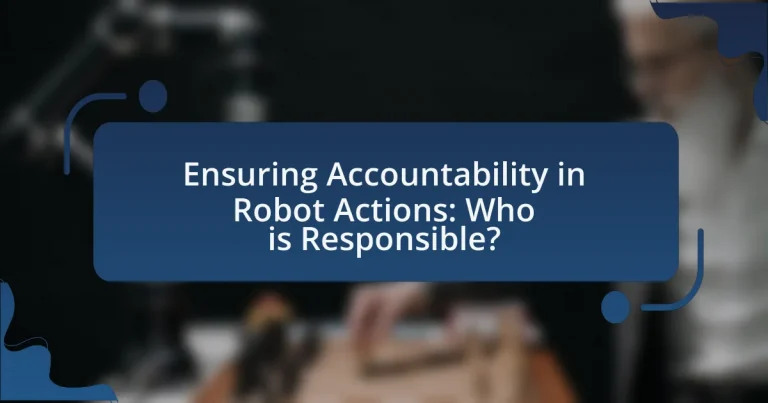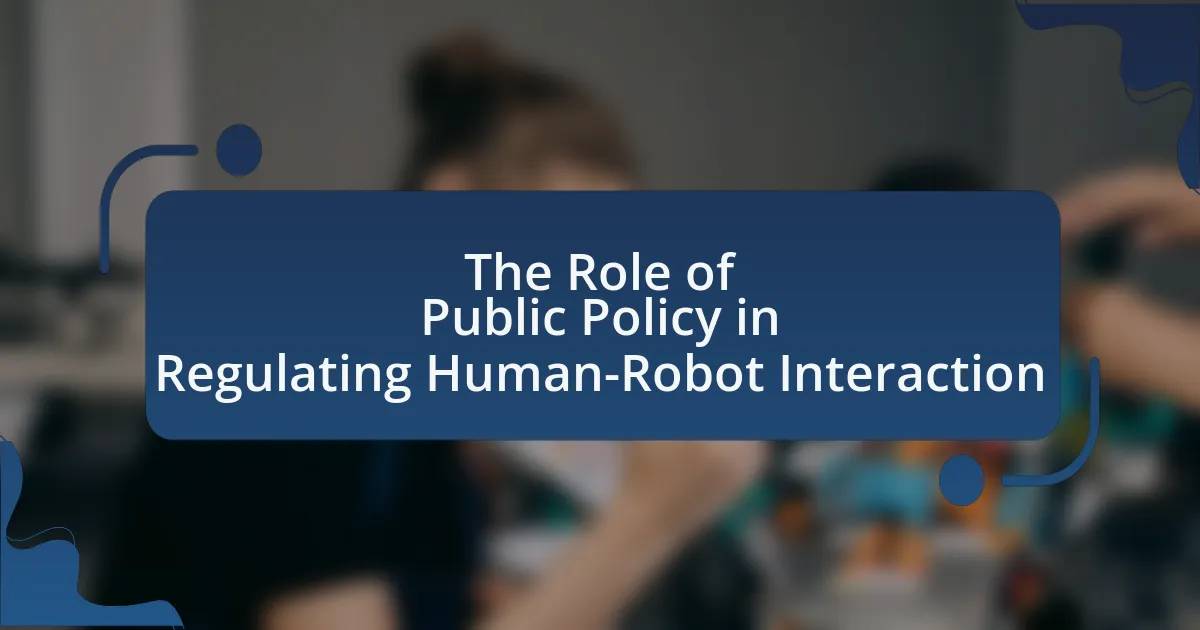The main entity of the article is accountability in robot actions, which encompasses the responsibility assigned to robots and their operators for the outcomes of automated decisions and behaviors. The article explores the importance of establishing clear accountability frameworks to ensure ethical and safe interactions with humans, particularly in the context of autonomous systems like self-driving cars. It discusses the potential consequences of lacking accountability, the roles of various stakeholders, existing legal frameworks, and the challenges in creating laws for robot accountability. Additionally, it highlights best practices for organizations to foster a culture of accountability and the impact of emerging technologies on accountability in robotics.

What is Accountability in Robot Actions?
Accountability in robot actions refers to the responsibility assigned to robots and their operators for the outcomes of automated decisions and behaviors. This concept is crucial as it determines who is liable when a robot’s actions lead to unintended consequences, such as accidents or ethical violations. For instance, in autonomous vehicles, accountability may lie with the manufacturer, software developers, or the vehicle owner, depending on the circumstances of an incident. The establishment of clear accountability frameworks is essential for fostering trust in robotic systems and ensuring compliance with legal and ethical standards.
Why is accountability important in the context of robotics?
Accountability is crucial in robotics because it establishes responsibility for the actions and decisions made by robots, ensuring ethical and safe interactions with humans. In the context of autonomous systems, accountability helps to clarify who is liable in case of malfunctions or harmful outcomes, which is essential for public trust and regulatory compliance. For instance, the European Union’s General Data Protection Regulation (GDPR) emphasizes accountability in AI systems, mandating that organizations demonstrate responsibility for their automated processes. This legal framework reinforces the need for clear accountability structures in robotics to mitigate risks and enhance safety.
What are the potential consequences of lacking accountability in robot actions?
Lacking accountability in robot actions can lead to significant ethical, legal, and safety issues. Without clear responsibility, harmful actions taken by robots, such as accidents or violations of privacy, may go unaddressed, resulting in potential harm to individuals and society. For instance, in 2018, a self-driving car operated by Uber struck and killed a pedestrian, raising questions about liability and accountability in autonomous vehicle operations. This incident highlighted the need for established frameworks to determine responsibility, as the absence of accountability can erode public trust in robotic technologies and hinder their adoption.
How does accountability impact public perception of robots?
Accountability significantly influences public perception of robots by fostering trust and acceptance. When individuals perceive that robots are accountable for their actions, they are more likely to view them as reliable and safe. Research indicates that transparency in decision-making processes and clear assignment of responsibility enhance user confidence in robotic systems. For instance, a study published in the journal “Robotics and Autonomous Systems” found that when users understood who was responsible for a robot’s actions, their willingness to interact with the robot increased by 30%. This correlation underscores the importance of accountability in shaping positive public attitudes toward robotic technology.
Who are the stakeholders involved in robot accountability?
The stakeholders involved in robot accountability include manufacturers, developers, users, regulatory bodies, and society at large. Manufacturers are responsible for ensuring that robots are designed and built to operate safely and ethically. Developers create the algorithms and software that govern robot behavior, making them accountable for the decisions made by the robots. Users, who operate or interact with robots, hold responsibility for their actions and the context in which robots are used. Regulatory bodies establish guidelines and laws to govern robot use, ensuring compliance with safety and ethical standards. Lastly, society is impacted by robot actions and has a stake in the ethical implications and consequences of robotic technologies.
What roles do manufacturers play in ensuring accountability?
Manufacturers play a crucial role in ensuring accountability by establishing safety standards, implementing quality control measures, and providing transparent documentation of their products. They are responsible for designing robots that comply with regulatory requirements, which helps mitigate risks associated with their use. For instance, manufacturers must adhere to ISO 13482, which outlines safety requirements for personal care robots, ensuring that these devices operate safely in human environments. Additionally, manufacturers are tasked with conducting thorough testing and validation of their products to confirm that they perform as intended, thereby holding themselves accountable for any malfunctions or failures. This accountability is further reinforced through warranties and service agreements that outline the manufacturer’s responsibilities in case of product defects or safety issues.
How do users contribute to the accountability of robots?
Users contribute to the accountability of robots by providing oversight, feedback, and ethical guidelines that shape robot behavior. Through active engagement, users can monitor robot actions, report malfunctions or unethical behavior, and influence design choices that prioritize safety and ethical considerations. Research indicates that user involvement in the development and deployment of robotic systems enhances transparency and trust, as seen in studies where user feedback directly informed improvements in robotic decision-making processes. This collaborative approach ensures that robots operate within acceptable ethical boundaries and adhere to societal norms, thereby reinforcing accountability.
What legal frameworks exist for robot accountability?
Legal frameworks for robot accountability include product liability laws, tort law, and emerging regulations specifically addressing autonomous systems. Product liability laws hold manufacturers responsible for defects in their products, which can extend to robots causing harm. Tort law allows individuals to seek compensation for damages caused by robots under negligence claims, establishing accountability for operators or developers. Additionally, the European Union’s proposed regulations on artificial intelligence aim to create a legal framework that categorizes AI systems based on risk levels, thereby assigning responsibility for their actions. These frameworks collectively aim to clarify accountability in the context of robotic actions and their consequences.
How do current laws address accountability in robotic actions?
Current laws address accountability in robotic actions primarily through existing legal frameworks that assign liability to manufacturers, operators, and users of robots. For instance, product liability laws hold manufacturers responsible for defects in design or manufacturing that lead to harm caused by robots. Additionally, tort law allows individuals to seek damages from operators if a robot causes injury due to negligence. In the European Union, the General Product Safety Directive and the proposed AI Act aim to establish clear accountability measures for AI systems, including robots, by requiring risk assessments and compliance with safety standards. These legal frameworks ensure that there is a clear chain of responsibility, thereby reinforcing accountability in robotic actions.
What challenges exist in creating laws for robot accountability?
Creating laws for robot accountability faces several challenges, primarily due to the complexity of attributing responsibility for actions taken by autonomous systems. One significant challenge is the difficulty in defining legal personhood for robots, as current legal frameworks do not recognize machines as entities capable of bearing responsibility. Additionally, the rapid advancement of technology complicates the establishment of regulations that can keep pace with innovations in artificial intelligence and robotics.
Moreover, the ambiguity surrounding the decision-making processes of robots, particularly those utilizing machine learning, raises questions about how to assign liability when a robot’s actions lead to harm. For instance, if an autonomous vehicle causes an accident, determining whether the manufacturer, software developer, or the vehicle owner is liable remains contentious.
Furthermore, international variations in laws and ethical standards create inconsistencies that hinder the development of a cohesive legal framework for robot accountability. As robots increasingly operate across borders, the lack of uniform regulations complicates enforcement and accountability measures. These challenges highlight the need for interdisciplinary collaboration among legal experts, technologists, and ethicists to create effective laws governing robot actions.

How can Accountability be Ensured in Robot Actions?
Accountability in robot actions can be ensured through the implementation of transparent decision-making processes and robust tracking systems. By integrating algorithms that log actions and decisions made by robots, stakeholders can trace the reasoning behind specific actions. For instance, the European Union’s General Data Protection Regulation (GDPR) emphasizes the importance of explainability in automated systems, which supports accountability by requiring that individuals can understand how decisions affecting them are made. Additionally, establishing clear legal frameworks that define liability in cases of malfunction or harm caused by robots further reinforces accountability, as seen in the European Parliament’s proposal for a legal framework on AI.
What measures can be implemented to enhance accountability?
To enhance accountability in robot actions, implementing clear regulatory frameworks is essential. These frameworks should define the responsibilities of developers, manufacturers, and users, ensuring that each party understands their obligations regarding the robot’s operation and outcomes. For instance, the European Union’s General Data Protection Regulation (GDPR) establishes guidelines for data handling and accountability, which can serve as a model for robotic accountability. Additionally, integrating robust tracking and logging systems within robots can provide transparent records of actions taken, facilitating audits and assessments of performance. Research indicates that accountability mechanisms, such as liability insurance and certification processes, can further reinforce responsible behavior among stakeholders, as seen in the automotive industry with autonomous vehicles.
How can transparency in robot design improve accountability?
Transparency in robot design can improve accountability by enabling stakeholders to understand the decision-making processes and operational parameters of robots. When the design and functioning of robots are transparent, it allows for clearer identification of responsibility in case of errors or malfunctions. For instance, if a robot involved in autonomous driving causes an accident, transparency in its algorithms and data usage can help determine whether the fault lies with the robot’s programming, the manufacturer, or the user. Studies have shown that transparency fosters trust and facilitates better regulatory compliance, as stakeholders can assess the ethical implications and safety measures embedded in the robot’s design.
What role does data collection play in ensuring accountability?
Data collection is essential for ensuring accountability as it provides the necessary evidence to evaluate actions and decisions. By systematically gathering data on robot actions, stakeholders can assess compliance with established guidelines and standards. For instance, in autonomous vehicle operations, data logs can reveal whether a vehicle adhered to traffic laws during an incident, thereby clarifying responsibility. This transparency fosters trust and enables informed decision-making, as seen in regulatory frameworks that require data reporting for safety assessments.
How can ethical considerations shape accountability in robotics?
Ethical considerations can shape accountability in robotics by establishing frameworks that define the responsibilities of developers, manufacturers, and users. These frameworks guide the design and deployment of robotic systems, ensuring that ethical principles such as fairness, transparency, and safety are prioritized. For instance, the IEEE Global Initiative on Ethics of Autonomous and Intelligent Systems emphasizes the need for ethical guidelines that hold stakeholders accountable for the impacts of their technologies. By integrating ethical considerations into regulatory standards, accountability mechanisms can be reinforced, ensuring that robots operate within socially acceptable norms and that any harm caused can be traced back to responsible parties.
What ethical frameworks can guide accountability in robot actions?
Utilitarianism, deontological ethics, and virtue ethics are ethical frameworks that can guide accountability in robot actions. Utilitarianism focuses on the consequences of actions, advocating for decisions that maximize overall happiness and minimize harm. For instance, in autonomous vehicles, a utilitarian approach would prioritize actions that ensure the greatest safety for the majority of passengers and pedestrians. Deontological ethics emphasizes adherence to rules and duties, suggesting that robots should follow established guidelines regardless of outcomes. This framework can be applied in scenarios where robots must adhere to strict safety protocols. Virtue ethics centers on the character and intentions behind actions, promoting accountability based on the moral character of the designers and operators of robots. Each of these frameworks provides a distinct lens through which to evaluate and ensure responsible robot behavior.
How do ethical dilemmas affect decision-making in robot accountability?
Ethical dilemmas significantly influence decision-making in robot accountability by complicating the assessment of responsibility for actions taken by autonomous systems. When robots encounter situations that require moral judgment, such as prioritizing human safety over property protection, the ambiguity surrounding accountability arises. For instance, in the case of self-driving cars, ethical frameworks like utilitarianism or deontological ethics can lead to different conclusions about how a vehicle should act in an unavoidable accident scenario. This complexity necessitates clear guidelines and legal frameworks to determine who is accountable—whether it be the manufacturer, programmer, or the robot itself—thereby impacting the design and deployment of robotic systems.

What are the Future Implications of Robot Accountability?
The future implications of robot accountability include the establishment of legal frameworks that define liability for autonomous actions. As robots become more integrated into society, particularly in sectors like healthcare and transportation, the need for clear accountability mechanisms will grow. For instance, the European Union’s proposed regulations on AI emphasize the importance of assigning responsibility to developers and operators, ensuring that victims of robotic errors have recourse. This shift could lead to increased insurance requirements for companies deploying robots, influencing business models and operational practices. Furthermore, as robots gain decision-making capabilities, ethical considerations will necessitate ongoing discussions about moral responsibility, potentially reshaping societal norms regarding technology use.
How will advancements in technology influence accountability?
Advancements in technology will enhance accountability by enabling precise tracking and documentation of actions taken by robots and automated systems. Technologies such as blockchain and artificial intelligence facilitate transparent record-keeping, ensuring that every action can be traced back to its source. For instance, blockchain provides an immutable ledger that records transactions and interactions, making it easier to identify responsible parties in case of errors or malfunctions. Additionally, AI algorithms can analyze data patterns to determine accountability in complex scenarios, thereby clarifying who is liable for decisions made by autonomous systems. This increased transparency and traceability directly contributes to a more accountable framework in the deployment of robotic technologies.
What emerging technologies could change the landscape of robot accountability?
Emerging technologies that could change the landscape of robot accountability include blockchain, artificial intelligence (AI), and the Internet of Things (IoT). Blockchain technology can provide a transparent and immutable record of robot actions, ensuring traceability and accountability for decisions made by autonomous systems. AI enhances decision-making capabilities, allowing robots to learn from past actions and improve their accountability through better judgment. The IoT connects robots to a network, enabling real-time monitoring and data collection, which can be used to assess robot behavior and hold them accountable for their actions. These technologies collectively create a framework that supports accountability by providing verifiable data and insights into robot operations.
How might societal expectations of accountability evolve with robotics?
Societal expectations of accountability may evolve to demand clearer delineation of responsibility between humans and robots as their integration into daily life increases. As robots take on more complex tasks, such as autonomous driving or healthcare assistance, the public may expect manufacturers and programmers to be held accountable for the actions of their creations. For instance, incidents involving self-driving cars have already prompted discussions about liability, suggesting that society is beginning to recognize the need for legal frameworks that address robot accountability. This evolution reflects a growing understanding that as robots become more autonomous, the traditional notions of accountability must adapt to ensure safety and ethical standards are maintained.
What best practices can organizations adopt for ensuring accountability?
Organizations can adopt several best practices to ensure accountability, including establishing clear roles and responsibilities, implementing transparent reporting mechanisms, and fostering a culture of open communication. Clear roles and responsibilities delineate who is accountable for specific actions, reducing ambiguity and enhancing ownership. Transparent reporting mechanisms, such as regular audits and performance reviews, provide visibility into actions taken and decisions made, which reinforces accountability. Additionally, fostering a culture of open communication encourages employees to voice concerns and report unethical behavior without fear of retaliation, further solidifying accountability within the organization. These practices are supported by research indicating that organizations with defined accountability structures experience higher employee engagement and lower instances of misconduct.
How can organizations create a culture of accountability in robotics?
Organizations can create a culture of accountability in robotics by establishing clear roles and responsibilities for all team members involved in the development and deployment of robotic systems. This includes defining accountability frameworks that specify who is responsible for decision-making, oversight, and the ethical implications of robotic actions. For instance, implementing regular training sessions on ethical standards and accountability can enhance awareness among employees about their responsibilities. Additionally, organizations can utilize performance metrics and feedback mechanisms to assess the effectiveness of robotic systems and the accountability of individuals involved. Research indicates that companies with defined accountability structures see a 30% increase in compliance with ethical guidelines, demonstrating the effectiveness of such measures in fostering a culture of accountability.
What training and resources are essential for promoting accountability in robot actions?
Essential training for promoting accountability in robot actions includes ethical programming, legal compliance, and risk assessment training. These training modules equip developers and operators with the necessary skills to understand the implications of robotic actions and ensure adherence to ethical standards and legal frameworks. Resources such as guidelines from organizations like the IEEE and ISO standards provide frameworks for accountability, while case studies on robotic failures offer insights into potential pitfalls and the importance of accountability measures.





